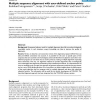Free Online Productivity Tools
i2Speak
i2Symbol
i2OCR
iTex2Img
iWeb2Print
iWeb2Shot
i2Type
iPdf2Split
iPdf2Merge
i2Bopomofo
i2Arabic
i2Style
i2Image
i2PDF
iLatex2Rtf
Sci2ools
ALMOB
2006
2006
Multiple sequence alignment with user-defined anchor points
Background: Automated software tools for multiple alignment often fail to produce biologically meaningful results. In such situations, expert knowledge can help to improve the quality of alignments. Results: Herein, we describe a semi-automatic version of the alignment program DIALIGN that can take pre-defined constraints into account. It is possible for the user to specify parts of the sequences that are assumed to be homologous and should therefore be aligned to each other. Our software program can use these sites as anchor points by creating a multiple alignment respecting these constraints. This way, our alignment method can produce alignments that are biologically more meaningful than alignments produced by fully automated procedures. As a demonstration of how our method works, we apply our approach to genomic sequences around the Hox gene cluster and to a set of DNA-binding proteins. As a by-product, we obtain insights about the performance of the greedy algorithm that our progr...
| Added | 10 Dec 2010 |
| Updated | 10 Dec 2010 |
| Type | Journal |
| Year | 2006 |
| Where | ALMOB |
| Authors | Burkhard Morgenstern, Sonja J. Prohaska, Dirk Pöhler, Peter F. Stadler |
Comments (0)

